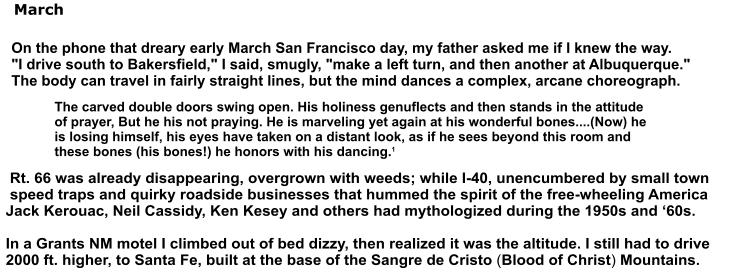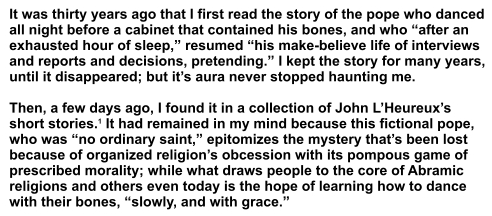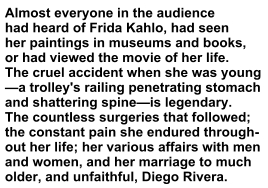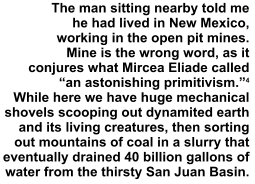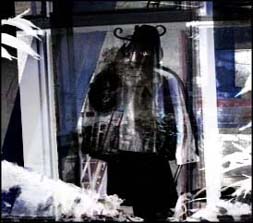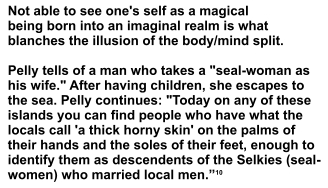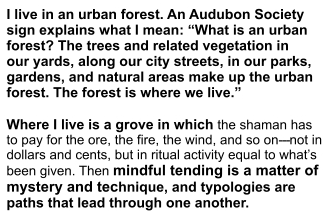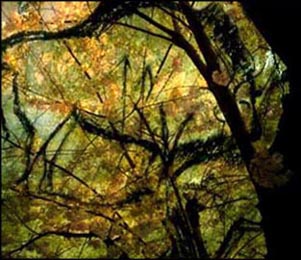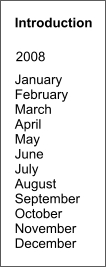
|
|
Upon first sight, dancing before one's skeleton is a play on shamanic initiation that was performed in Siberia, such as among the Tungus, in which initiates were "killed," in order to see if they had the extra bone with which shamans are born. In other parts of the world the operation varied. For example, in Australia magical substances such as crystals replaced some normal bone structure. In all cases, the initiate is stripped down to his or her scaffolding, then sacred elements are substituted for the profane. In L'Heureux's story, the shaman/pope has been resurrected without his bones, which, locked in a cabinet, glow "with a life, with a soul, of their own." The pope is a closet ghost. I wonder what holds his bag of skin up. Is it faith? This is what exoteric religions would have us believe. Or is it the knowledge that living the ironic double of life and death, the insight of esoteric spiritual Ways, is what makes us human? Christianity maps life through death, a route on which one can hear the Gospel of Reincarnation hummed just loud enough to make the psyche dance a few cuneiformed steps.
March 5. An old friend—old friends are the reward one gets for living a long life—wrote: "I notice despite your eschewment of Judaism you dwell on Religion an awful lot." I replied that, as Americans are obsessed with religion, how can I not discuss it? I am constantly reminded of this because a church's amplified bells pound on my windows every half-hour, eight hours every day. Such arrogant imposition does not lead one to the numinous, but to the ego's fata morgana. Australian Jungian scholar David Tacey writes: "Contact with the numinous, with what is infinite and other, is fraught with emotional reactions, resistances, defences, and enthusiasms."2 The numinous is a dance of simple steps that have deep effects. People on its many paths, most without tonsure or robes, don't speak of a consummate Truth. Their vision is of breathless truths revealed in verdurous metaphors.
7. Jacqueline West, an analyst from Santa Fe, arrived last night to deliver the monthly lecture at Oregon Friends of C.G. Jung. When her talk began, the lights were turned off, and on a screen appeared the dramatic paintings of Frida Kahlo. A man bent into the aisle, trying to catch enough light to see his notebook. I scribbled a few lines, writ large: "Why are the gods so bloody?" "She paints from the inside out, finding her body there." "The suffering!" And a quote from Dr. West, "She was born into death."
"By embracing her own individuality, however cruel was her experience of it, Frida endured extraordinary challenging encounters with the gods."5 Painting her favorite subject, herself, she became an icon transfused by many bloodlines: Spanish, Mexican, Native American, Hungarian Jew, to name a few. Scribbling in the dark, not knowing if the words were crossing out each other, I thought about how self-conscious I feel when I stop in the street to make notes; people walking around me, maybe thinking, "What's he writing that is so important?"
Caught red-handed, with words first formed with red ochre drawn onto Paleolithic walls while animal spirits danced in the flickering shadows. Neurons that lighted those pitch-black caves are still firing today. As "various fires must bear the indelible mark of their own individuality,"7 the immeasurable impulse to make one's mark continues to move us. Near the end of her two-hour talk, West pointed out how in one painting the wings of a bird Frida wore as a pendant echo the black wings of her eyebrows. Light as a feather, her body had assumed the avian grace of the Holy Ghost—
10.
What does the well-dressed poet wear to work these days? He prefers a causal smoking jacket, and a matching pair of Bermuda Shorts. Brown loafers cover his bare feet, their Thom McAnn box used to file letters of rejection. To compliment his freshly-shaved scalp, he wears a Land's End fishing cap, stuck with an assortment of colorful lures, any one of which could draw blood. And to make sure he is “at the forefront of existential masculinity,” with a half-empty bottle of Mountain Dew, he is ready take his hybrid Toyota Werewolf for a spin.
16. What was clearly seen yesterday, this morning is hidden in fog. Is the familiar world still there? I know that everything is constantly changing re-forming. Even though the belfry can’t be seen, the bells ring down the streets. Slowly, a few buildings, then a scrim of evergreen trees, appear.
18. The Wakan Rōei Shū,12 presents a poem by the 8th Century poet, Fujiwara No Atsumochi:
The editors comment that the poem "alludes to chapter 20 of the Chuang Tzu, 'The Mountain Tree.' Chuang Tzu points out (in [Burton] Watson's translation), 'Because of its worthlessness, the tree is able to live out the years Heaven gave it.' But soon afterward, his disciples questioned him about the matter, beginning their inquiry in this manner: 'Yesterday there was a tree in the mountain...'"13 Years ago I reworked this passage from Chuang Tzu into a poem titled, "Useless":
Besides living in midst of forest rich with oak, I had two things in mind. One was Thomas Merton's statement that in a capitalist society the role of the monk is to be useless; e.g., someone who's work can't be exploited.15 The second was that America has no use for its poets. At best, a few dead poets—Walt Whitman, Carl Sandburg, Robert Frost, T.S. Eliot—are enshrined in the public mind. This was on my mind when Humboldt's Gift, Saul Bellow's novel based on the life of the poet Delmore Schwartz, was published. On July 11, 1966, Schwartz had died of a heart attack in the lobby of a cheap Times Square hotel, virtually penniless and friendless after years of drug and alcohol abuse. Writing from his home in Chicago, Bellow's cry is monumental:
This paragraph echoes the last lines of Lew Welch's "Chicago Poem," written a few years earlier—
You can walk away from a place, but you are always the only place you inhabit. Although Lew Welch left Chicago for Northern California, "He drank far too much, had a way with guns, and took one with him into the woods, never to be seen again..."18 He left a note that, in part, said: "I had great visions but never could bring them together with reality. I used it all up. It's all gone."19 There was a rumor, never confirmed, that his body was found and left, as he wished, for the vultures. His "Last Will & Testament" ends:
20. A dark morning, the clocks are turned forward but my ancestors still haunt me. I don't know who they were. I have no pictures older than a few strangers standing stiffly, staring, without smiling, into the lens of a camera. Are my dreams the engrams of their dreams? Do they speak through me the words that I write? Are the visions I see theirs too? I express them more etymologically than genetically: each word a mouth, each clause an eye, each sentence an ear, each paragraph a nose; every project another family reunion.
In America, too, only the aboriginals have been here long enough to be here. For most Americans, as their deity has been transplanted through the myths of a distant land, tracking the Divine in the pages of a book.
This reflects Dōgen Zenji's Mountains and Waters Sūtra: "Mountains' walking is just like human walking. Accordingly, do not doubt mountains' walking even though it does not look the same as human walking."23
23.
Walking up a steep hill in Portland...climbing a steep trail above Santa Fe, in the gaps where memories are strengthened into beliefs, lives are coerced into mimicking the past.
1-
L'Heureux, J. "Roman Ordinary." In, Desires. New
York, NY, 1981. |
